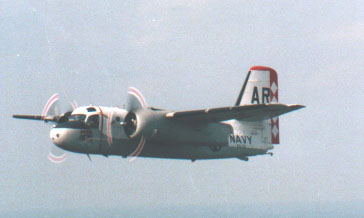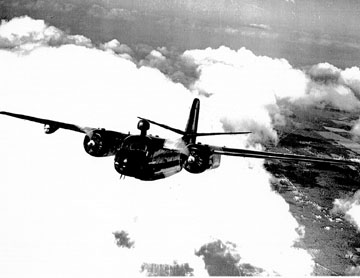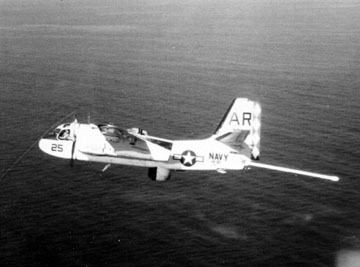Grumman S2F / S-2 Tracker Basics

136427 in flight over Indiana
 |
Grumman S2F / S-2
Tracker Basics
|
 |
Nickname
"Stoof" (S-Two-F)
Detection Equipment
(16) SSQ-2 sonabuoys
carried in the rear engine nacelles
AN/APS-38 search radar
which dropped down in a radome from the fuselage
Magnetic Anomaly Detection
(MAD) boom extending from the tail
70 million candlepower
searchlight on starboard wing
Armament
(6) 5 in. HVAR rockets
(1) Mk 34 or 43 anti-submarine
torpedo
(20) Marine Markers (smoke)
Crew
Pilot
Co-pilot/navigator
(1) Sonabuoys operator-starboard
side
(1) Radar operator-port
side
Dimensions
Length 42 ft.
Height 16 ft , 2 in.
Wing Span 68
ft., 8 in.
Weight
26,000 lbs. gross
Power Plants
(2) Wright R-1820-82,
1,525 horsepower each
Performance
Max. speed - 265 mph
Service Ceiling
22,000 ft.
Range
900 miles
Total Built
1,438 of which 755
were of the S2F-1/S-2A variation
Nomenclature
In the early
60's the military went to a standard method of identifying its aircraft.
You will see different types of designations for the Grumman Tracker.
Below is a conversion table to help you keep the various models straight;
S2F-1 became the S-2A
- The first flight was Dec. 4, 1952 and 755 were built, of which 130 of these
were for export to US allies. DeHavilland of Canada also built 99 under license.
S2F-1T became the TS-2A
S2F-1S became the S-2B
S2F-1F1 became the S-2F
S2F-2 became the S-2C - 60 of these were
produced which had slightly enlarged tail surfaces, Julie and Jezebel detection
gear, and an extended weapons bay to better accommodate the large nuclear
weapons of the period.
S2F-2P became the RS-2C

S-2C
S2F-3 became the S-2D - 100 were built;
several features were enlarged including the engine nacelle, which doubled to 32
the amount of sonabuoys that could be carried, fuel tanks, fuselage, tail
surfaces and wingspan.
S2F-3S became the S-2E
WF-2
became the E-1B - This was the Airborne Early Warning (AEW) version of the
Tracker, with nicknames "Stoof with a Roof' and "Willie Fudd".
The 88 Tracers replaced the AD-5W Skyraider and saw extensive service during the
early parts of the Vietnam war, providing CAP and controlling Alpha Strikes over
North Vietnam.

E-1B
US-2A,B,C,D
- Another
variant of the Tracker was the utility series which when complete would involve
the conversion of 243 anti submarine versions into utility aircraft.
History
The Second World War demonstrated to the
U.S. Navy that one of the key weapons needed to combat the deadly menace
of unrestricted submarine warfare was a carrier based hunter-killer anti-submarine
aircraft. The Navy took delivery of its first Grumman S2F-1 Tracker
in October of 1953. The Tracker was the Navy’s first anti-submarine
aircraft that combined both the sub hunter and killer roles in one airframe.

Combat
The
Tracker never really saw any anti-submarine combat with the US Navy for which it
was designed. And
that is good, for its primary mission was to seek out and destroy, if the
circumstances demanded, enemy submarines. The Tracker was a cold war
weapon, with the enemy being in this case the Soviet Union and Warsaw Pact
countries. The Tracker was a part of a strategy of strong deterrence, and
because it was effective in its mission, it never had to be used launch its
weapons on a Soviet missile submarine.
That being said, during the war in Southeast Asia,
the Tracker was heavily involved in patrol duty not only for hostile submarines,
but for surface vessels. At least one and possibly two were lost ( I have
seen conflicting evidence) when a Tracker on patrol in SEA did not return to the
carrier.
It should be noted that S2F Trackers did see combat
in 1981 with the Argentine Navy against British forces during the Falklands War.
For more information see the following website:
http://www.centronaval.org.ar/boletin/bcn/BCN817/817fortini.pdf
This is the English language translation Countries that have and still may be
using The Tracker:
(Argentina, Australia, Brazil,
Canada, Italy, Japan, Netherlands, Peru (not shown), Taiwan, Thailand, Turkey, Uruguay, USA,
Venezuela)
|













